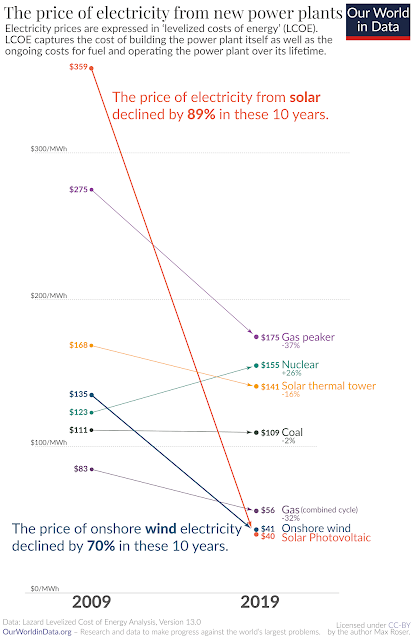This article was first published in Castanet Dec 26, 2023 / 6:00 pm |
Something is happening in the background in British Columbia that will set the stage for renewable electricity for the next 50 years. BC Hydro is about to issue a “clean power call” -- they will ask for independent power producers to submit proposals for building and operating clean energy plants.
 |
| Our World in Data CC-BY |
Until recently, BC Hydro was certain all new electricity demand could be met by the Site C hydroelectric dam, now expected to come online in 2025. Now BC Hydro believes that more electricity will be needed. Why the change? BC Hydro now predicts that demand will be higher for three reasons: population growth, electrification and two new fields: liquified natural gas and green hydrogen.
It is worth pointing out that electricity use doesn’t need to grow with population. Per capita growth depends on energy efficiency standards (like the BC Step Code). In fact, if we are going to slow or reduce global warming we absolutely must reduce electricity use per person.
Electrification means shifting activities that currently use fossil fuels to relatively clean electricity. This would include increasing the number of electric vehicles and switching home heating and cooling from fossil fuel furnaces to heat pumps.
Natural gas comes in “light” and “heavy” versions. The light version of natural gas is found via drilling, transported by pipeline, and used in “nearby” homes and businesses. The “heavy” version of natural gas is extracted via drilling, transported by pipeline to the coast, compressed into liquified natural gas and transported around the world by tanker. Compression and ocean shipment require a great deal more energy than the light version. Originally the Kitimat liquefied natural gas facility intended to use BC’s clean electricity (87% hydro) to compress the natural gas, however BC doesn’t have surplus electricity or the infrastructure to deliver huge amounts of electricity to Kitimat. Instead the liquefied natural gas plant will burn natural gas to compress the natural gas. This makes the fossil fuel even more polluting.
BC also has its eye on producing hydrogen. People think of hydrogen as the equivalent of gas, but free since it is available from the air we breathe. However, extracting hydrogen from the air demands a lot of power. You can generate this power with a coal fired power plant -- that’s brown hydrogen or you can generate this power with renewables -- that’s green hydrogen.
So these demands -- population increase, electrification, liquid natural gas and green hydrogen -- mean that BC will need more electricity than expected and more electricity than can be provided by the Site C hydroelectric dam.
The actual “Power Call”, where companies prepare bids and submit them to BC Hydro will happen in the spring of 2024. Contracts will be awarded spring-summer of 2025 and the projects should be delivering power by the fall of 2028.
This particular power call is for “clean energy” which could include a wide array of technologies, including ocean waves, biomass or waste heat. However, due technological maturity and drops in cost, the majority of proposals will be for solar and wind (BC Hydro will also accept proposals for battery storage). According to The International Renewable Energy Agency energy costs in 2022 for wind are 3 cents per kilowatt hour; whilst utility‑scale solar is 5 cents per kilowatt hour.
In fact the timing of the power call is ideal. BC has a healthy local market for wind and solar developers but the power call may bring in competition from Alberta. Many wind and solar developers in Alberta have been hard hit by a sudden announcement by the conservative government on August 3 of a moratorium on renewables -- freezing 13 projects in the approval process and halting 118 projects in the pipeline, according to the Pembina Institute.
After these clean power projects are brought online BC should be in a very strong position: A very high percentage of renewables, with a balance between dispatchable energy from hydro and renewables with different intermittent profiles: wind and solar.
Articles and cartoons on Teaspoon Energy by Kristy Dyer are licensed under a Creative Commons Attribution-NoDerivatives 4.0 International License You may reprint this as-is for free.
Comments
Post a Comment